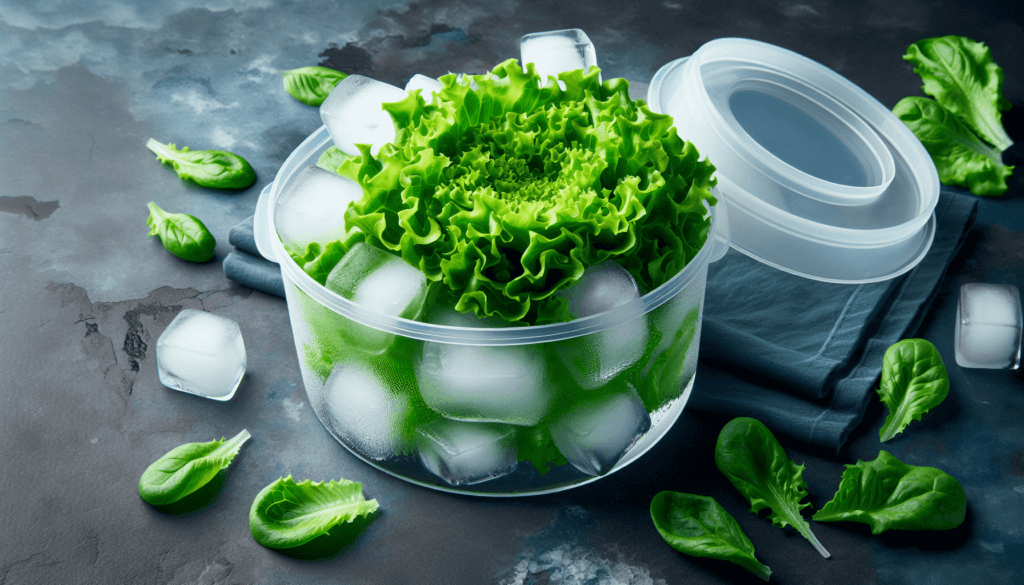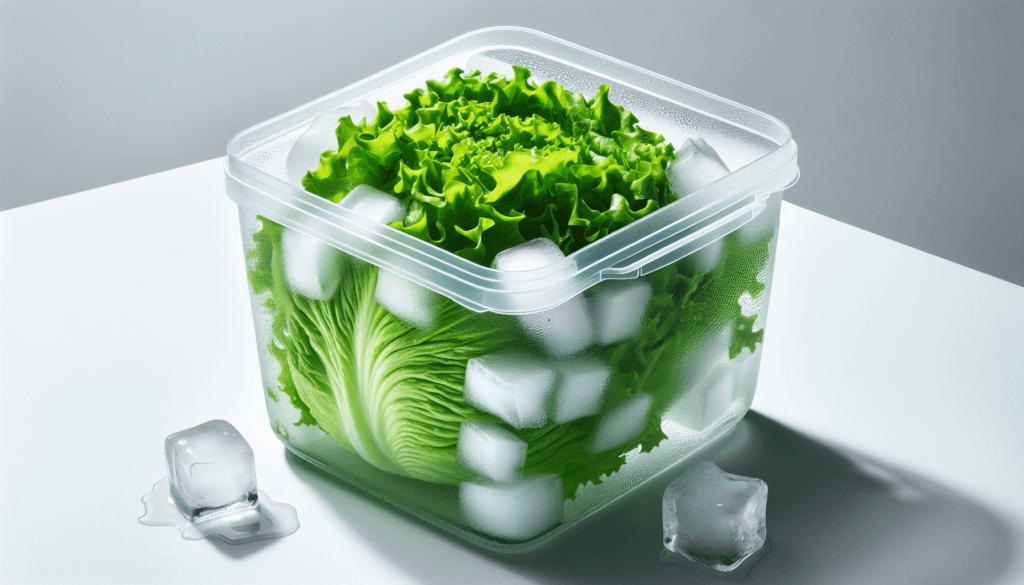You love a good salad, but there’s nothing worse than reaching into your fridge to find wilted, soggy lettuce. Don’t worry, we’ve got you covered with these 10 kitchen hacks for keeping your lettuce fresh and crisp. From proper storage techniques to clever tricks, you’ll never have to suffer through limp lettuce again. So grab your favorite greens and get ready to enjoy the fresh, crunchy goodness in every bite!
Proper Storage
Choosing fresh lettuce
When it comes to storing lettuce properly, the first step is to choose the freshest lettuce possible. Look for lettuce that is crisp and vibrant in color. Avoid any brown or wilted leaves, as they indicate that the lettuce is past its prime. Additionally, opt for lettuce that is kept in a cooler section of the grocery store or farmers market, as exposure to heat can cause lettuce to wilt more quickly.
Trimming and washing
Before storing lettuce, it is important to trim and wash it properly. Start by removing any damaged or wilted leaves and cutting off the bottom of the lettuce head. Then, fill a sink or large bowl with cold water and immerse the lettuce, gently swishing it around to remove any dirt or debris. After a thorough rinse, shake off any excess water.
Drying the lettuce
To ensure that your lettuce stays crisp and fresh, it is crucial to dry it thoroughly before storing. Excess moisture can lead to bacterial growth and cause the lettuce to wilt more quickly. There are several methods you can use to dry your lettuce effectively. The simplest way is to pat the leaves dry with a clean kitchen towel or paper towels. Alternatively, you can use a salad spinner, which will remove excess water by spinning the lettuce at high speeds. Remember, the drier the lettuce, the longer it will stay fresh.
Using the Right Containers
Airtight containers
One of the keys to keeping lettuce fresh is to store it in airtight containers. Airtight containers create a barrier that prevents moisture from getting in and keeps the lettuce from drying out. Look for containers that have a tight-fitting lid and are made of clear plastic or glass, as these materials allow you to see the contents without opening the container. Make sure to choose a container that is large enough to accommodate the size of your lettuce, without crushing the leaves.
Paper towel method
Another option for storing lettuce is the paper towel method. Start by lining a container with a few layers of paper towels. Place the lettuce on top of the paper towels and cover with another layer of paper towels. The paper towels will absorb any excess moisture and help to keep the lettuce crisp. Replace the paper towels as needed to prevent them from becoming damp.
Plastic bags with holes
If you prefer to store your lettuce in bags, opt for plastic bags with small holes. These bags allow for proper air circulation, preventing the build-up of excess moisture that can lead to rotting. Simply place the lettuce in the bag, making sure not to overcrowd it, and loosely tie the top to allow for air flow. This method works particularly well for storing loose leaf lettuce or pre-washed lettuce.

Keeping Moisture at Bay
Adding a paper towel
To further extend the freshness of your lettuce, consider adding a paper towel to the storage container. Place a dry paper towel at the bottom of the container and another on top of the lettuce. This additional layer of absorbency will help to absorb any excess moisture that may accumulate during storage, ultimately keeping your lettuce fresh and crisp.
Using a salad spinner
If you enjoy eating salads frequently or have a large quantity of lettuce to store, investing in a salad spinner is a wise choice. A salad spinner not only helps to dry lettuce thoroughly, but it also keeps the leaves crisp and fresh for an extended period. After washing the lettuce, simply place it in the salad spinner and spin it at high speeds to remove as much water as possible. This method is especially effective for delicate lettuce varieties like butterhead or leaf lettuce.
Storing with a dishtowel
An alternative to using a paper towel is to store lettuce with a clean dishtowel. After washing and drying the lettuce, wrap it loosely in a clean dishtowel and place it in a container or produce bag. The dishtowel will absorb any excess moisture and help to maintain the crispness of the lettuce. Make sure to change the dishtowel regularly to prevent it from becoming damp or dirty.
Utilizing Refrigerator Tricks
Adjusting refrigerator temperature
The temperature of your refrigerator plays a significant role in the freshness of your lettuce. It is best to store lettuce at a temperature between 32-36°F (0-2°C). Lower temperatures can cause lettuce to freeze and become damaged, while higher temperatures can promote bacterial growth and accelerate wilting. Check the temperature settings of your refrigerator and make any necessary adjustments to keep your lettuce in its optimal storage conditions.
Utilizing the crisper drawer
Most refrigerators come equipped with a dedicated crisper drawer, designed to maintain humidity levels and prolong the freshness of fruits and vegetables. To store your lettuce properly, place it in a clean and dry crisper drawer, away from other fresh produce items. The crisper drawer will help to regulate humidity and prevent the lettuce from drying out or becoming overly moist.
Keeping lettuce away from ethylene-producing fruits
Certain fruits, such as apples, pears, and bananas, produce a natural gas called ethylene as they ripen. This gas can speed up the ripening process of other fruits and vegetables that are stored nearby. To prevent your lettuce from wilting prematurely, keep it away from ethylene-producing fruits in the refrigerator. This will help to maintain the freshness and crispness of the lettuce for a longer period.

Freezing Lettuce
Blanching the lettuce
If you have an excess amount of lettuce and want to preserve it for later use, freezing is a viable option. However, due to its high water content, lettuce does not freeze well without some preparation. The first step is to blanch the lettuce. Blanching helps to retain the color, texture, and nutritional value of the lettuce. To blanch, bring a pot of water to a boil and submerge the lettuce leaves for a brief 30 seconds. Then, transfer the lettuce to an ice bath to cool rapidly and stop the cooking process.
Freezing in portions
After blanching, it is essential to freeze the lettuce in manageable portions. Use airtight freezer bags or containers to prevent freezer burn and maintain the quality of the lettuce. Portion the blanched and cooled lettuce into smaller quantities based on your anticipated usage. This way, you can easily thaw and use the lettuce without having to defrost the entire batch.
Thawing and using frozen lettuce
When it’s time to use the frozen lettuce, thaw it in the refrigerator overnight or under cold running water. Avoid thawing it at room temperature, as this can promote the growth of bacteria. Once thawed, gently rinse the lettuce under cold water to remove any ice crystals. Frozen lettuce works best in cooked dishes, such as soups, stir-fries, or casseroles, as the texture may change slightly after freezing.
Vacuum Sealing Lettuce
Using a vacuum sealer
Vacuum sealing is an efficient method to keep lettuce fresh for an extended period. Vacuum sealers remove air and create an airtight seal around the lettuce, preventing moisture loss and preserving its crispness. To vacuum seal lettuce, place the cleaned and dried lettuce in a vacuum-sealable bag. Follow the instructions on your vacuum sealer to remove the air and seal the bag tightly.
Preventing moisture buildup
While vacuum sealing lettuce can help to maintain its freshness, it is essential to ensure that the lettuce remains dry inside the sealed bag. Moisture can still accumulate over time, leading to a soggy texture. To prevent moisture buildup, consider adding a layer of paper towel or a desiccant packet to the bag before sealing. These will help to absorb any excess moisture and keep the lettuce dry for a more extended period.

Reviving Wilted Lettuce
Soaking in cold water
If you find that your lettuce has wilted and lost its crispness, there are ways to revive it. One method is to soak the lettuce in cold water for about 15-30 minutes. Fill a bowl or sink with cold water and submerge the wilted leaves. The cold water will hydrate the lettuce and restore its crispness. After soaking, pat dry the lettuce using a clean kitchen towel or paper towels before using it in your desired recipe.
Using ice water bath
Another effective way to revive wilted lettuce is by giving it an ice water bath. Fill a large bowl with ice-cold water and add a handful of ice cubes. Submerge the wilted lettuce leaves in the ice water bath, ensuring that they are fully immersed. Let the lettuce sit in the ice bath for approximately 20-30 minutes or until it regains its crisp texture. Once revitalized, remove the lettuce from the water, gently shake off any excess moisture, and pat it dry before using.
Preventing Browning and Oxidation
Applying lemon juice
Lettuce, particularly varieties like romaine or iceberg, can oxidize and turn brown when exposed to air. To prevent browning, you can apply lemon juice to the cut edges or leaves of the lettuce. Lemon juice acts as a natural antioxidant, slowing down the oxidation process and preserving the freshness of the lettuce. Squeeze fresh lemon juice directly onto the lettuce or dip a brush or paper towel in lemon juice and brush it onto the cut edges.
Covering cut edges with plastic wrap
When storing lettuce with cut edges, such as romaine hearts or butterhead lettuce, it is important to protect those exposed areas from air exposure. Place a piece of plastic wrap directly over the cut edges of the lettuce, pressing it firmly to create a seal. This barrier will prevent air from reaching the cut edges, preventing browning and oxidation. Make sure to store the lettuce with the plastic wrap intact until ready to use.

Storing Leftover Salad
Separating dressing and toppings
Leftover salad can be tricky to store, as the dressing can cause the lettuce to become wilted. To prevent this, it is best to store the dressing separately. Transfer the salad into an airtight container, leaving out any wet or moist ingredients, such as dressing, tomatoes, or cucumbers. Store the dressing separately in a small sealed container or jar. When ready to enjoy the salad, simply add the dressing and any other desired toppings.
Using airtight containers
When storing leftover salad, it is crucial to use airtight containers to maintain freshness. Choose containers that are the appropriate size for the amount of salad you are storing, and ensure that the lid fits tightly to create an airtight seal. Airtight containers prevent air from entering the container and help to keep the salad crisp and flavorful for longer. If you don’t have airtight containers, you can also use resealable plastic bags, squeezing out as much air as possible before sealing.
Choosing the Right Lettuce Variety
Selecting the right type
The type of lettuce you choose can impact its storage requirements and longevity. Different lettuce varieties have varying levels of crispness and shelf life. Crisphead lettuce, such as iceberg or romaine, tends to be more resilient and can stay fresh for longer periods. Loose leaf lettuce, on the other hand, is more delicate and prone to wilting. Consider your storage needs and preferences when selecting lettuce and choose the variety that suits your needs best.
Different storage requirements
Each lettuce variety has specific storage requirements to ensure optimal freshness. It is essential to familiarize yourself with the storage recommendations for the specific type of lettuce you have chosen. Some lettuce varieties, like romaine, prefer cooler storage temperatures, while others, like butterhead lettuce, may benefit from slightly warmer temperatures. By understanding the ideal storage conditions for each lettuce variety, you can maximize its freshness and extend its shelf life.



